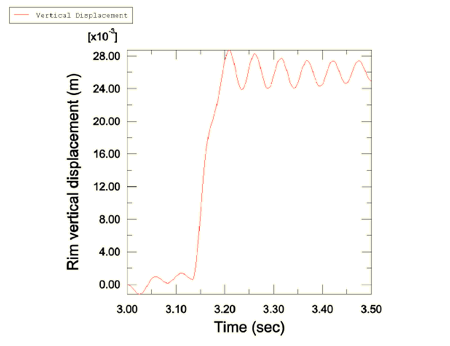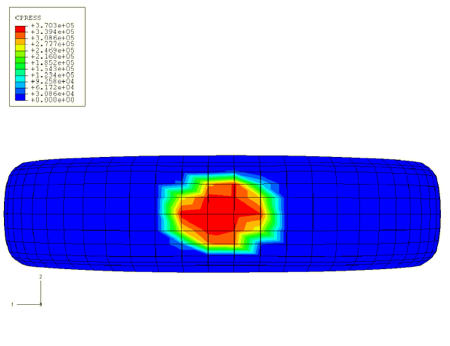Problem description and model definition
The model used in this example differs slightly from that used in Symmetric results transfer for a static tire analysis. Since only elements common to both Abaqus/Standard and Abaqus/Explicit can be imported, reduced-integration solid elements are used in this example and nodes in the bead area are attached to rigid elements representing the rim. A plot of the tire before impact with the curb, a 0.025 m high step, is shown in Figure 1. The large rigid body rotation involved in a transient rolling analysis necessitates the use of the nondefault second-order-accurate kinematic formulation in the explicit dynamic analysis. In addition, it is recommended that the enhanced hourglass control scheme be used for both Abaqus/Standard and Abaqus/Explicit for all import analyses. Use section controls in the axisymmetric analysis to specify the enhanced hourglass control scheme.
The inflation and footprint preloads are applied in a series of general analysis steps identical to those described in Symmetric results transfer for a static tire analysis. Symmetric model generation and symmetric results transfer are used to exploit the symmetric nature of the structure and loading (see Symmetric Model Generation and Transferring Results from a Symmetric Mesh or a Partial Three-Dimensional Mesh to a Full Three-Dimensional Mesh).
The repeated dynamic impact of tire nodes as they come into contact with the road is an unavoidable source of the high frequency noise that can be seen in the reaction force at the rim. The viscoelastic property of the matrix provides sufficient damping to reduce such high frequency noise. No material damping (mass proportional or stiffness proportional) is necessary in this case. The viscoelastic stress contributions from the steady-state transport analysis are imported into the Abaqus/Explicit analysis.





